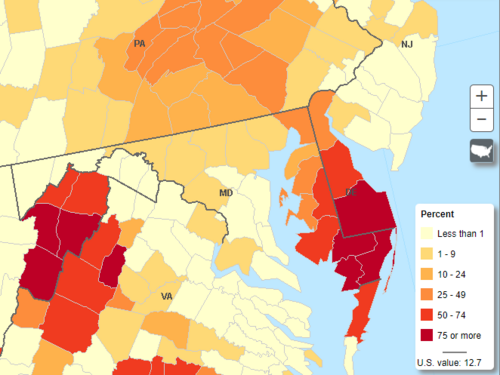Mitigating anticipated impacts of increased nutrient runoff from flashy precipitation from poultry agriculture in the Chesapeake watershed
Real-world agriculture resilience scenario used to drive the concept map development
To anchor the "decision" end of the "data to decisions" pipeline, we shall focus on a use-case centered on climate adaptation challenges in the Chesapeake watershed. In particular, we focus on poultry agriculture in the Delmarva Peninsula (derived from the names of the States of Delaware, Maryland, and Virginia). The figure below shows USDA agriculture census data representing the value of poultry and eggs sold as a percentage of the total market value of agricultural products in 2017.
The hypothetical use-case involves an inter-county task force ("task force") charged with drafting a regional resilience plan to ameliorate the impacts of climate change on the economy and biodiversity of the Chesapeake watershed. First, the task force convened a multitude of stakeholders to derive a common understanding of the risks and vulnerabilities. Stakeholders included business owners, farmers, critical infrastructure operators, economic planners, scientists, environmental engineers, and government representatives. A shared understanding of the challenges facing the region was captured in a number of concept maps. These concept maps proved to be effective as visual communication tools to share the stakeholders' common understanding of the challenges confronting their communities.
Subsequently, the task force charged a team of transdisciplinary ESIP folks (yay!!!!) to develop a technology plan to support science-informed, data-driven decision-making. The ESIP folks were asked to first focus on meeting the needs of the poultry agriculture industry. However, the technology plan should also be scalable to meet the needs of other areas of concern like enhancing coastal flood abatement civil infrastructure, enhancing the long-term sustainability of Chesapeake oyster farms, etc.

(Image source: https://www.nass.usda.gov/Publications/AgCensus/2017/Online_Resources/Ag_Census_Web_Maps/, retrieved 2020-03-28 1615 hrs GMT.)